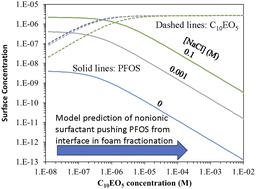当前位置:
X-MOL 学术
›
Environ. Sci.: Processes Impacts
›
论文详情
Our official English website, www.x-mol.net, welcomes your
feedback! (Note: you will need to create a separate account there.)
A fundamental model for calculating interfacial adsorption of complex ionic and nonionic PFAS mixtures in the presence of mixed salts
Environmental Science: Processes & Impacts ( IF 4.3 ) Pub Date : 2023-03-20 , DOI: 10.1039/d2em00466f Yi Gao 1 , Song-Thao Le 1 , Tohren C G Kibbey 2 , William Glamore 1 , Denis M O'Carroll 1
Environmental Science: Processes & Impacts ( IF 4.3 ) Pub Date : 2023-03-20 , DOI: 10.1039/d2em00466f Yi Gao 1 , Song-Thao Le 1 , Tohren C G Kibbey 2 , William Glamore 1 , Denis M O'Carroll 1
Affiliation

|
Per- and polyfluoroalkyl substances (PFAS) are emerging contaminants that have been used extensively as firefighting agents and in a wide range of commercial applications around the world. As many of the most-common PFAS components are surfactants, they readily accumulate at interfaces, a process that can govern their environmental fate. There are thousands of PFAS compounds, and they have nearly always been used as mixtures, so it is common to find many different PFAS components present together in the environment. Furthermore, the interfacial behavior of ionic PFAS can be strongly influenced by the presence of salts, with adsorption dependent on both the composition and concentration of salts present. Any predictions of PFAS interfacial behavior made without considering both the mixed nature of PFAS present, as well as the composition of the salts present, have the potential to be off by orders of magnitude. To date, models capable of making predictions of PFAS interfacial adsorption when both mixed PFAS and mixed salts are present have not been presented. The work described here addresses this need by extending a mass-action model developed previously by the authors to allow predictions in cases where complex combinations of mixed PFAS and mixed salts are present. Predictions of PFAS interfacial affinity for a range of PFAS mixture conditions and ionic strengths are verified using experimentally-measured surface tension data. The new model provides physically-realistic prediction of interfacial adsorption of a wide range of PFAS mixtures over a wide range of salt concentrations and compositions. The model is capable of predicting interfacial adsorption of ionic/nonionic PFAS mixtures in the presence of salts, and can also make predictions when there is competitive adsorption between different PFAS components, a common case in PFAS source zones where high concentrations of multiple components are present and in foam fractionation reactors.
中文翻译:

计算混合盐存在下复杂离子和非离子 PFAS 混合物界面吸附的基本模型
全氟烷基物质和多氟烷基物质 (PFAS) 是新兴污染物,已被广泛用作消防剂并在世界各地进行广泛的商业应用。由于许多最常见的 PFAS 成分都是表面活性剂,它们很容易在界面处积聚,这一过程可以控制它们的环境命运。 PFAS 化合物有数千种,而且它们几乎总是以混合物的形式使用,因此在环境中经常会发现许多不同的 PFAS 成分同时存在。此外,离子 PFAS 的界面行为会受到盐的存在的强烈影响,吸附取决于盐的组成和浓度。如果不考虑 PFAS 的混合性质以及盐的组成,对 PFAS 界面行为的任何预测都有可能出现几个数量级的偏差。迄今为止,尚未提出能够预测同时存在混合 PFAS 和混合盐时 PFAS 界面吸附的模型。这里描述的工作通过扩展作者之前开发的质量作用模型来满足这一需求,以允许在存在混合 PFAS 和混合盐的复杂组合的情况下进行预测。使用实验测量的表面张力数据验证了对一系列 PFAS 混合物条件和离子强度的 PFAS 界面亲和力的预测。新模型提供了各种 PFAS 混合物在各种盐浓度和成分下的界面吸附的物理真实预测。 该模型能够预测盐存在下离子/非离子 PFAS 混合物的界面吸附,并且还可以预测不同 PFAS 组分之间存在竞争吸附的情况,这是存在高浓度多种组分的 PFAS 源区的常见情况以及泡沫分馏反应器中。
更新日期:2023-03-20
中文翻译:

计算混合盐存在下复杂离子和非离子 PFAS 混合物界面吸附的基本模型
全氟烷基物质和多氟烷基物质 (PFAS) 是新兴污染物,已被广泛用作消防剂并在世界各地进行广泛的商业应用。由于许多最常见的 PFAS 成分都是表面活性剂,它们很容易在界面处积聚,这一过程可以控制它们的环境命运。 PFAS 化合物有数千种,而且它们几乎总是以混合物的形式使用,因此在环境中经常会发现许多不同的 PFAS 成分同时存在。此外,离子 PFAS 的界面行为会受到盐的存在的强烈影响,吸附取决于盐的组成和浓度。如果不考虑 PFAS 的混合性质以及盐的组成,对 PFAS 界面行为的任何预测都有可能出现几个数量级的偏差。迄今为止,尚未提出能够预测同时存在混合 PFAS 和混合盐时 PFAS 界面吸附的模型。这里描述的工作通过扩展作者之前开发的质量作用模型来满足这一需求,以允许在存在混合 PFAS 和混合盐的复杂组合的情况下进行预测。使用实验测量的表面张力数据验证了对一系列 PFAS 混合物条件和离子强度的 PFAS 界面亲和力的预测。新模型提供了各种 PFAS 混合物在各种盐浓度和成分下的界面吸附的物理真实预测。 该模型能够预测盐存在下离子/非离子 PFAS 混合物的界面吸附,并且还可以预测不同 PFAS 组分之间存在竞争吸附的情况,这是存在高浓度多种组分的 PFAS 源区的常见情况以及泡沫分馏反应器中。











































 京公网安备 11010802027423号
京公网安备 11010802027423号